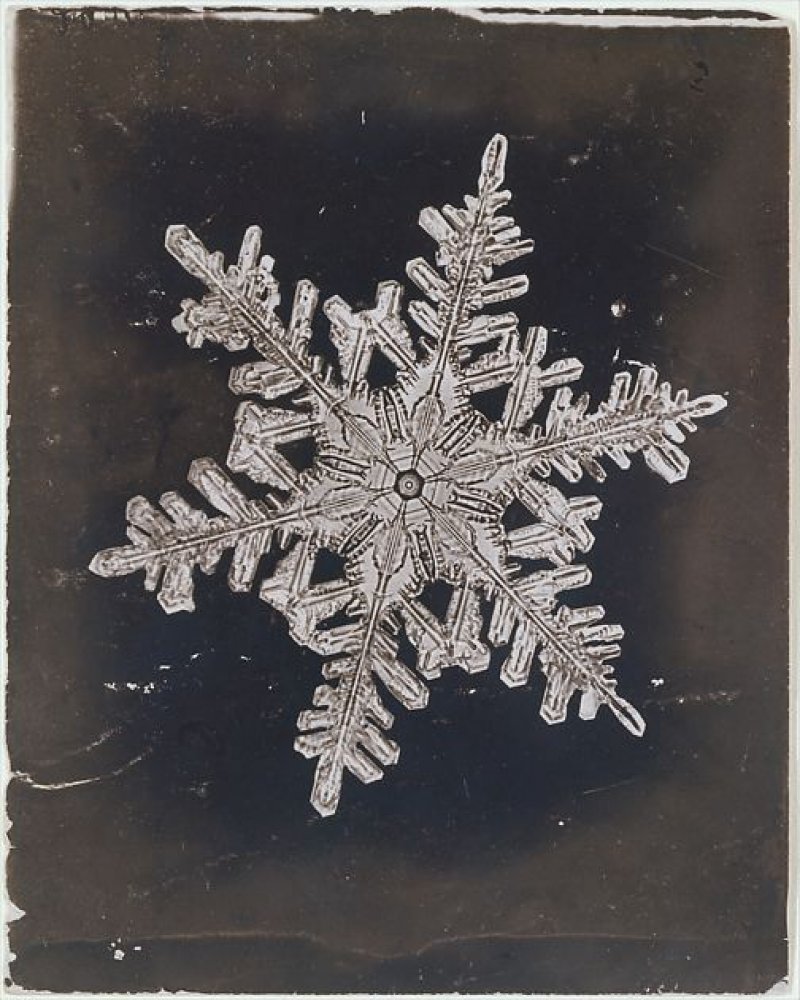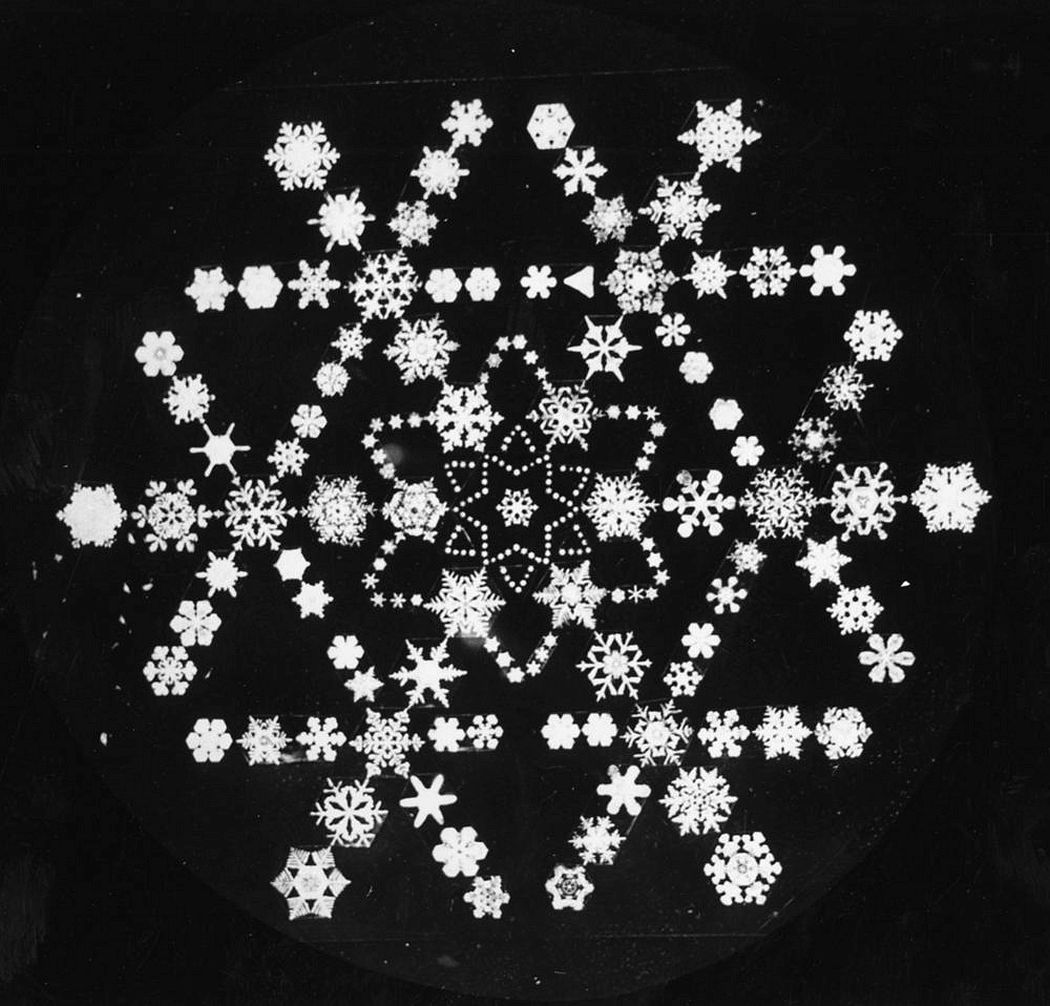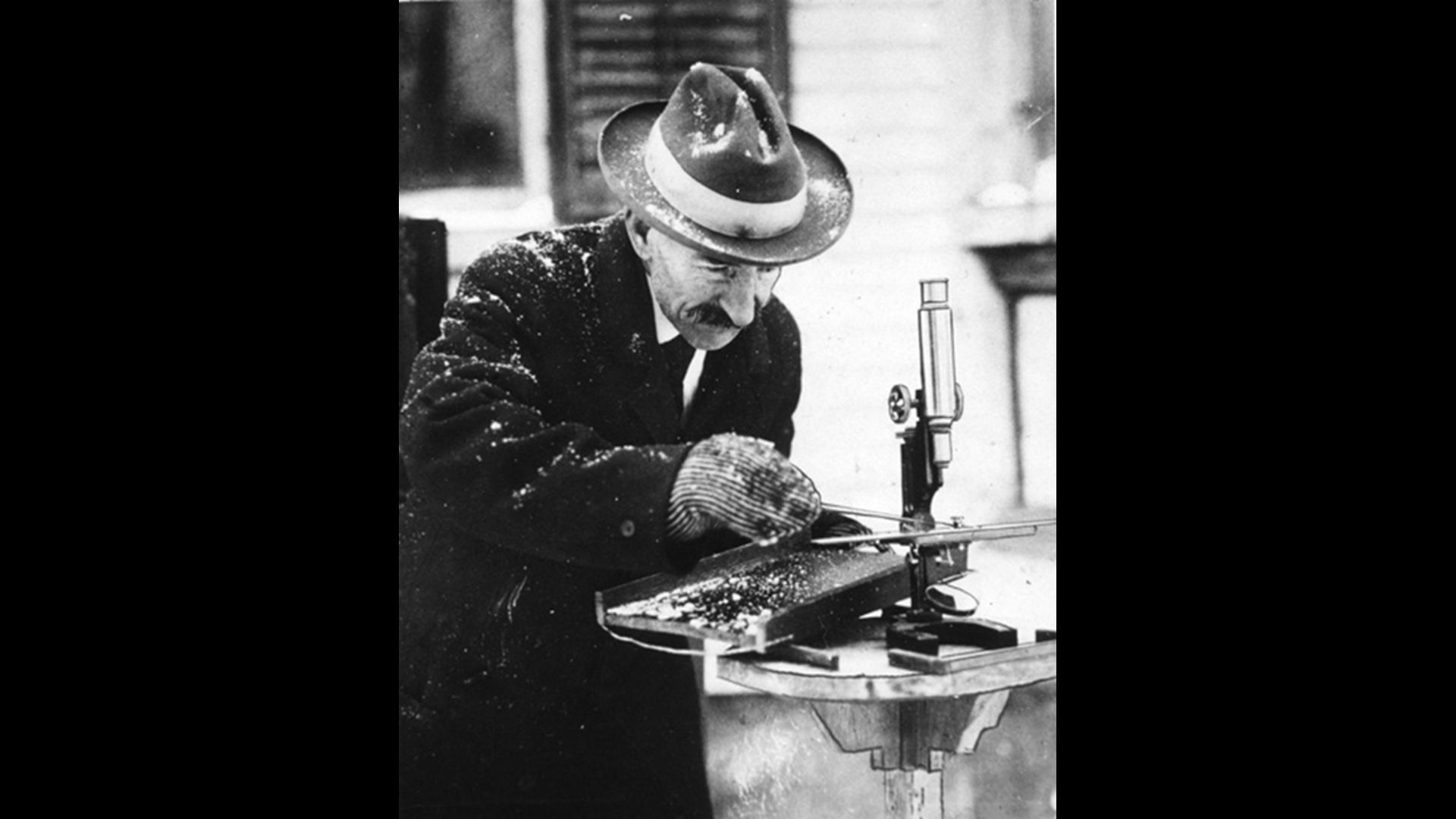Text: Anne Hemkendreis | Section: Art-Related Science
Abstract: The US-American Wilson A. Bentley is today considered one of the first atmospheric scientists. His photomicrographs of ice crystals testify to an intensive examination of the physical dimension of observing nature and the impossibility of subject-independent research. As early examples of so-called SciArt, Bentley’s photomicrographs are evidence of a historically close connection between art and science. According to the w/k classification, Bentley’s photomicrographs fall into the category of Art-Related Scientists. While Bentley himself can be described as an aesthetically proceeding meteorologist, his photographs are ambiguous threshold phenomena. They demonstrate the importance of aesthetics in the communication of scientific knowledge.
Perhaps the most famous name in early atmospheric science belongs to a passionate layman: the U.S. farmer’s son Wilson A. Bentley (1865-1931). An examination of his numerous photographs of ice crystals provides insight into the challenges of meteorological research around 1900 and how they were communicated. Bentley’s practical (popular) scientific procedures and aesthetic communication strategies earned his studies accusations of lacking objectivity. On closer inspection, however, Bentley’s deliberately arranged photomicrographs are based on the recognition of the persistent influence of a subject’s physicality in empirical research.[1]
The visualization of snow and ice began in Sweden in 1555 with a woodcut by the bishop and cartographer Olaus Magnus. The woodcut and its fascinating motifs testify to the great challenge of studying the rapidly changing and tiny ice crystals with merely the eyes.[2] This problem can be traced to the research of René Descartes. The English scientist Robert Hook eventually perceived the icy weather phenomenon not only with the naked eye, but through a microscope, while still transferring what he saw onto paper with a pencil. Only Bentley supplemented his work with the microscope by photography. From now on, observations of snow crystals apparently objective and accurate seemed feasible, since the researching subject could physically be excluded from the visualization process to a large extent. In addition, there was no time delay in the imaging process.

However, Bentley’s activities in, what from today’s perspective can be called an early form of science communication, ultimately led to a reintegration of haptics into his experimental procedures. The reason for this was Bentley’s interest in the visual attraction of the objects he observed as well as in their unique shapes resulting from the temperature of different atmospheric layers.
Meteorological Practice in the Home Laboratory
Bentley’s weather observations, conducted since 1882, were devoted to the different altitudes of the atmosphere and their temperature-dependent changes. His central interest was the relationship between cloud formations and the appearances of ice crystals.[3] Bentley concluded that the shape of clouds – which had already preoccupied artists and scientists of the 19th century [4] – had no effect on the either fan-like spreading or tabular-columnar appearance of the ice crystals; the only decisive factors were their varying temperature and oxygen content depending on altitude. Bentley proceeded meticulously to note down prevailing weather conditions and record their visual evidence – meaning the ice crystals – in photographs.
In his studies, Bentley – unlike Ernst Haeckel (1834-1919) – was not primarily interested in determining the type of his research objects, but in understanding how they took shape. The interior design of the ice crystals told Bentley something about the nature of air, made different degrees of coldness visible and included them in a symmetrical form, in icy air channels that could be observed under the microscope.[5] Bentley was interested in ice crystals as storage media of constantly occurring invisible processes in nature, which, in turn, shaped each snowflake individually on its journey to earth.
“Was ever life history written in more dainty hieroglyphics?”[6], wondered Bentley, searching for a method to decode the secret language of ice crystals. In his theory, the tiny crystals thus became witnesses of the fundamental physical laws of nature manifesting themselves in miniature:
“Water, being a magnetic substance, and susceptible to polar repulsion, presumably has a tendency to arrange itself thus, in a position between and at right angles to the primary electro-magnetic poles. This alignment of the lines of growth, opposite to the lines of greater magnetic force, would compel the crystals of snow to grow mainly outward in the directions of their equatorial diameters and secondary poles.”[7]
According to Bentley, magnetism and galvanism were responsible for the shape of ice crystals and revealed their independend dynamics in a symmetrical form.
However, in order not to destroy the delicate objects of investigation in the experiment, a particularly complicated handling was required, in which the body of the scientist had to be kept at distance. That is why Bentley used specially developed practices of indirect touch, which even included his own breath. He conveyed the trapped ice crystals to a support plate with a delicate feather and carefully pressed them there so as not to damage them.[8]
He also took advantage of the winter cold that filled his home laboratory – a shed at his parents’ house in wintry Jericho, Vermont.[9] After taking a draft of cold air, he always held his breath and only then continued his experiments.
However, since air that is too cold can also cause snow crystals to evaporate, and since any change in temperature in general influences the formal structure of ice crystals, Bentley had only a time limit of 10 to 300 seconds to photograph them. By holding the glass plate with the snow crystals not with his hands, but with the help of two gripping tongs, he gained some time. But the attempts to exclude not only the circumstances of the investigation, but also the researching subject (i.e. himself) as a distorting influence, were laborious. Initially, the light falling on the plate resulted in photographs of barely identifiable transparent objects on a bright background. Bentley therefore proceeded to cut out his images and to carefully scrape off the gelatin layer around them before then photographing the negatives individually or arranging them to collages on a black background.[10] In doing so, he was guided by the aesthetic ideal of symmetry, which he saw as necessary for the broadly effective communication of his observations.
Ideal Science? Aesthetic Communication for the Evocation of Evidence
A recurring motif in Bentley’s weather observations is his admiration of natural wonders, which sometimes even took on religious overtones.[11] Bentley succeeded in taking the first photomicrograph of an ice crystal on 15 January 1885, and since then (because of its uniqueness and symmetrical shape) considered it a secret language of nature and a bridge between heaven and earth. Therefore, in the years from 1898 to 1904, he also studied related phenomena, such as rain and dew or frost and weather glow. Bentley regularly published his research results in popular and scientific journals such as Montly Weather Review, Country Life, National Geographic, Popular Mechanics, and The New York Times Magazine.[12] Scientific circles, however, remained reserved.
Bentley therefore began to include his photographs as lantern slides in his lectures and also sent them to archives, universities, and museums until the 1920s. [13] As the New York Times reported on 27 January 1890, demonstrations with the Magic Lantern were generally popular among amateur photographers at the turn of the century.[14] Bentley used the aesthetic appeal of about 4500 glass plates to attract non-expert audiences in particular to his presentations.
From today’s perspective, especially Bentley’s work in exhibition contexts appears unusual. In 1901, he showed his ice crystals at the Pan-American Exhibition in Buffalo (NY), which gave him an enormous boost in popularity.[15] Perhaps to offset the vanishing size of his objects of study, or perhaps to illustrate his understanding of ice crystals as entities assembled according to internal principles, Bentley created an impressive collage of 125 crystals that measured about 152 cm in diameter.[16]
For the visitors of the exhibition it remained unclear whether their gaze fell on a snowflake composed of numerous ice crystals and (as by the view under a microscope) strongly enlarged, or on an abstract work of art. Scientific practice and its reception thus overlap in Bentley’s aestheticizing practice. Until today, Bentley’s little-noticed collages (other versions are known from his early research years) are perhaps the most striking examples of his unusual work at the threshold of art and science. In Bentley’s collages the aesthetic visualization of empirical findings results in stunning objects of epistemic value.

In fact, Bentley also considered (applied) artists as his target audience. Through the aesthetic attraction of his ice crystals, he hoped that his empirical observations would immigrate into people’s everyday culture:
“The snow crystals being, in the truest sense, exquisite works of art in themselves. They charmingly adapt to a great variety of uses in the industrial arts, and in various other ways. These uses are steadily broadening, though they and their artistic possibilities have as yet hardly been discovered or realized by artisans in general. Metal workers and wall paper manufacturers are, however, beginning to realize their value, and there should be a great field of usefulness for them in these lines. They also seem well adapted for use in designing patterns for porcelain, china, glassware and many other things. Silk manufacturers are beginning to see their adaptability as patterns.”[17]
The dissemination of his scientific observations through their inclusion in the applied arts formal catalogue was a component of Bentley’s activity as a researcher that should not be underestimated. Instead, it should be understood as a skillful strategy of scientific communication. Contrary to what Bentley suggested, however, the artistic value of snow crystals did not simply result from their appearance in photography; rather, it required the physical intervention of the scientist, that is, a deliberate aesthetic selection and composition.
It was precisely this artistic method, however, that was to become problematic for Bentley’s acceptance in the scientific community. As he used techniques such as blocking out, trimming crystals for irregularities and arranging them into collages to make his scientific results visible, Bentley developed highly creative and individual procedures for communication. [18] Unfortunately, as a result, the scientific claim of his studies has already been doubted during his lifetime and still is today.
Conclusion: Strategies for making Natural Processes visible
In their research on the history of science Lorraine Daston and Peter Galison classify Bentley’s aestheticizing procedures as indicative of a pre-modern belief in a perfection of natural processes without consideration of the irregular and asymmetrical.[19] In contrast, I assert Bentley’s critical treatment of a phantasm in the history of science which has often been ignored. Especially Bentley’s experience of physical exposure to the cold during his experimental studies, his conscious handling of the destructive effect of his own breath, the development of complex techniques of mediated touch, and finally the insights concerning the physical principles of attraction and repulsion led Bentley to the realization that even (apparently) objective science is not free from subjective imprinting. After all, what Bentley underlines is that the complicated distancing of objects from one’s own bodily heat is inescapably followed by the reintegration of the scientist’s subjective choice in moments of selection, visualization, and mediation.
This is particularly evident in Bentley’s artistic collages, which are not images of natural phenomena, but, refer to the physical laws of nature within the atmosphere, while just as clearly emphasizing the intervention of the scientist to make them visible. Instead of assigning Bentley’s snow crystals to a pre-modern understanding of science, it seems more adequate to understand them as early objects of SciArt, since here complex scientific findings are processed for the general public in an aesthetic way.[20] Bentley’s snow crystals would thus be media of reflection on the inseparable unity of man and nature, communicated broadly in the intersection of scientific and aesthetic practice.[21]
According to the w/k system, Bentley’s photomicrographs are classified as Art-Related Scientists; meaning that a scientist makes us of artistic concepts and/or methods in teaching, lectures, or – as in this case – publications. While Bentley himself can be defined as an artistically proceeding scientist, his ice crystals are hybrid media on the threshold between art and science, which is the reason for their enduring and fascinating attraction.
Picture above the text: Anonymous: Wilson Bentley at Work (1917). Photo: Duncan C. Blanchard. The Snowflake Man. A Biography of Wilson A. Bentley, Newark/Ohio 1998, Cat. 14.
[1] For further information on the claim of objectivity in the field of science: Jürgen Ritsert, Was ist wissenschaftliche Objektivität? In: Leviathan, 26,2, 1998, pp. 184-198, 185.
[2] Duncan E. Blanchard, The Snowflake Man. A Biography of Wilson A. Bentley, Newark, Ohio 1998, 49. Also see the article On the Six-Cornered Snowflake by Johannes Kepler (1610) and a drawing by René Descartes (1635) in reference to the article. In 1660 Erasmus Bartholinus draw a snowflake with great emphasis on its details. For further information on the visual culture of ice and snow: Klaus Dodds, Ice. Nature and Culture, London 2018.
[3] Wilson A. Bentley, Snow Beauties. In: History of Jericho, Vol. 1, 1916, without page numbers.
[4] On the science of clouds and their metaphoric meaning of eternity: Johannes Stückelberger, Wolkenbilder. Deutungen des Himmels in der Moderne, München, Paderborn 2010, 10.
[5] Bentley 1916 (cp. fn. 3).
[6] Duncan C. Blanchard, The Snowflake Man, in: Weatherwise, 23,6, 1970, pp. 260-269.
[7] Bentley 1916 (cp. fn. 3).
[8] Shel Izen, A Passionate Life: Wilson Bentley’s Snow Crystal Lantern Slides, in: The Magic Lantern Gazette, Vol. 19,4, 2007, pp. 3-7, here 4.
[9] Ibid., 4 und Blanchard 1998 (cp. fn. 2), here 4.
[10] Carlos E. Cummings, Wilson A. Bentley. Snowflake Plates acquired, in: Weatherwise, 23/6, 1970, pp. 240-259.
[11] Blanchard 1970 (cp. fn. 6), here 266.
[12] Blanchard 1970 (cp. fn. 6), here 267. Bentleys first article was published 1898 on an advice of George Perkins, Professor at the University of Vermont, USA.
[13] Blanchard, 1970 (cp. fn. 6), here 267.
[14] Izen 2007 (cp. fn. 8), here 4.
[15] Izen 2007 (cp. fn. 8), here 5.
[16] Blanchard 1998 (cp. fn. 2), here 77-78.
[17] Bentley 1916 (cp. fn. 3).
[18] Wilson A. Bentley, Photographing Snowflakes, in: Popular Mechanics Magazine, 37 (no year), pp. 309-312, here 310-312.
[19] Lorraine Daston und Peter Galison, Objektivität, Frankfurt am Main 2007, pp. 161-163. Daston describes the turn to the objective gaze which excludes the physical as a “Changing tides in the observation science.” Cp. ibid., 14.
[20] Craig Stevens, Gabby O’Connor, Natalie Robinson, The Connections between Art and Science in Antarctica, in: Polar Record, 2009, 55, 4, 289-296, here 290. The term “SciArt” is used especially in research on contemporary climate-critical art and science, and is thus most closely associated with snow research. Wilson Bentley’s snow crystals are to be located in a line of tradition with these objects at the interface between art and science. Instead of representation, SciArt focuses on environmental communication, especially with non-expert audiences in mind. The authors locate the beginnings of this form of communication at the beginning of the 20th century.
[21] Fred Hapgood, When ice crystals fall from the sky art meets science. In: Smithsonian, No. 6, 1976, 66-73.
How to cite this article
Anne Hemkendreis (2021): Icy Hieroglyphics: Wilson Bentley's Snow Crystals. w/k–Between Science & Art Journal. https://doi.org/10.55597/e7077


Comments are closed.